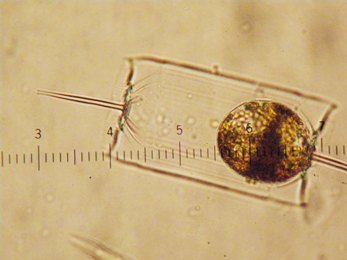by Russel Barsh
The onset of fall rains and persistent mild temperatures have produced a late bloom of the bright green marine diatom Ditylum brightwelli in East Sound.
Like all diatoms, Ditylum are encased in capsules or “frustules” of silica, which protects them but also makes them heavier and liable to sink in still waters. Forming long chains may make them more buoyant and help prolong their lives.
When plenty of nutrients are available, Ditylum reproduces very rapidly by cell division. Then it switches to a kind of sexual reproduction in which individual cells “conjugate” to form larger cells with two sets of chromosomes. These later divide, producing daughters with remixed genes.
We might expect that floating diatoms, pushed around helplessly by tides and currents, would be pretty evenly mixed up genetically over an area as large as the Salish Sea. But Ditylum forms genetically distinct sub-regional groupings in Puget Sound and the Strait. Another common diatom in our nearshore waters, Skeletonema costatum, was also found to form genetically distinct local populations. How do they maintain their connection to a particular bay? Diatoms can form resting cells that allow them to remain buried alive in mud and sand on the seafloor for years, then emerge and bloom. This enables them to sit out adverse environmental conditions. It also means that locally adapted populations can form and maintain their distinctiveness.
Ditylum is sensitive to copper and zinc, associated with contamination from automobiles and powerboats. At high concentrations of these metals Dytilum photosynthesizes less, and cell division results in large numbers of defective offspring. Other nearshore diatoms may also be affected, and this could link road runoff and moored boats to phytoplankton abundance and, as a consequence, the abundance of forage fish such as herring.
**If you are reading theOrcasonian for free, thank your fellow islanders. If you would like to support theOrcasonian CLICK HERE to set your modestly-priced, voluntary subscription. Otherwise, no worries; we’re happy to share with you.**








